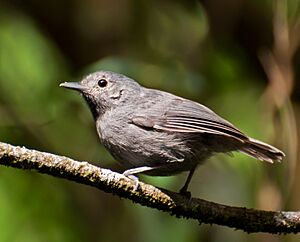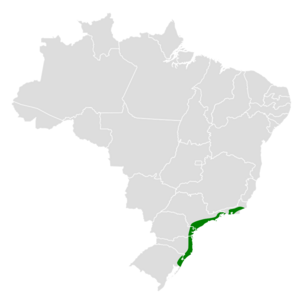Unicolored antwren facts for kids
Quick facts for kids Unicolored antwren |
|
|---|---|
 |
|
| Male in São Paulo, Brazil | |
| Conservation status | |
| Scientific classification | |
| Genus: |
Myrmotherula
|
| Species: |
unicolor
|
 |
|
The unicolored antwren (Myrmotherula unicolor) is a small bird found in southeastern Brazil. It belongs to a group of birds called "typical antbirds." This bird is special because it lives only in Brazil, meaning it is endemic there.
Contents
What is the Unicolored Antwren?
The unicolored antwren is a small bird, about 9 to 10 centimeters (3.5 to 4 inches) long. That's about the length of a pen! It weighs around 6.5 to 8 grams (0.2 to 0.3 ounces), which is lighter than a few paper clips. It has a short tail.
How to Identify a Male Antwren
Adult male unicolored antwrens are mostly gray. Their top parts are a bit darker gray than their belly and chest. The feathers on their throat have black bases but gray tips, making them look mostly gray.
How to Identify a Female Antwren
Adult female antwrens look different from males. Their upper body is olive-brown, with a slight gray color on their head and neck. The feathers covering their upper tail are yellowish-brown. Their wings are dark grayish-brown with reddish-yellow-brown edges. Their tail is also reddish-yellow-brown. Their throat is whitish, and their belly is mostly olive-buff, turning grayer on their sides.
Where Does the Unicolored Antwren Live?
The unicolored antwren lives in the Atlantic Forest, a special type of forest along the coast of southeastern Brazil. You can find it from the northern part of Rio de Janeiro state down to northern Rio Grande do Sul.
What Kind of Habitat Does It Prefer?
This bird likes to live in the lower and middle parts of evergreen forests. It also lives in older secondary forests, which are forests that have grown back after being cut down. In some places, it lives in "restinga" woodlands. These are forests that grow on white-sand soils. The antwren prefers dense, vine-filled areas in forests where the trees are not too tall, usually up to about 20 meters (65 feet) high. It lives from sea level up to about 500 meters (1,640 feet) above sea level.
Behavior and Life Cycle
The unicolored antwren is thought to stay in the same area all year round. It does not migrate.
What Does the Unicolored Antwren Eat?
We don't know all the details about what the unicolored antwren eats. However, it likely eats mostly insects and spiders. It hunts for food alone, in pairs, or with its family. Sometimes, it joins groups of different bird species that are feeding together.
It usually looks for food between 0.5 and 5 meters (1.6 to 16 feet) above the ground. But it can also go as high as 15 meters (49 feet) to find food. It searches carefully among tangled vines, on leaves (both living and dead), stems, and branches. It often reaches out and stabs its prey. It also catches food by hanging upside down, hovering to pick up insects, or flying out from a perch to grab something.
Reproduction and Nests
The breeding season for the unicolored antwren is not fully known. However, nests with eggs or chicks have been seen in November. The nest is shaped like a cup. It is made from roots, dead leaves, and parts of fungi. The bird hangs its nest from a fork in a tree branch, usually within 2 meters (6.5 feet) of the ground. We don't know how many eggs it lays, how long the eggs take to hatch, or how long it takes for the young birds to leave the nest. We also don't know much about how the parents care for their young.
What Does the Unicolored Antwren Sound Like?
The unicolored antwren's song is a series of very high, sharp, and drawn-out notes that sound like "Seeep." These notes are not regular and are spaced out. Its calls include a sharp "wheet," two nasal notes together, and longer, flat, raspy notes.
Status and Conservation
The IUCN (International Union for Conservation of Nature) keeps track of how many animals are left in the wild. In 1994, they said the unicolored antwren was "Vulnerable," meaning it was at risk. In 2004, it was listed as "Near Threatened." But since 2023, it has been listed as "Least Concern." This means it is not currently at high risk of extinction.
Even though its status improved, the total number of unicolored antwrens is not known and is believed to be going down. The biggest threat to this bird is the loss of its home, the forest. Most of the lowland Atlantic Forest where it used to live has been cut down. This happened because people moved into the area, cut down trees for wood, and cleared land for farming.
The unicolored antwren is considered uncommon throughout its range. It does live in several protected areas, especially in the northern part of its habitat. More research is needed to find out exactly where this bird lives and how many there are, especially in the southern parts of its range.


